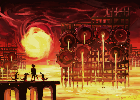Protoellipses
Heat. Pressure. The taste of metallic air. Trying to scream, but hearing only silence. The weightless sensation of falling. These phenomena and others like them are common in protoellipses (via Greek, lit. protos "first" + elleipsis "omission"), psychic impressions encoded into the Guage Keys by the psychic effects of dragon fire. The term "protoellipsis" originates from dragonfire therapy, where negative phenomenological states are scoured from the mind and crystalized into small, globular crystals. It was believed that only the first mental states thus scoured would crystallize, hence "proto", but later research determined that further states were simply encoded deeper into the crystal. The term nevertheless persists.
Dragons possess the mental fortitude to endure protoelliptic visions, and some are even known to weaponize them in self-defense. We mortals, lacking such strength, must borrow it. As is well-documented in Gustivus Pulluman's celebrated Seventy Yet More Unexpected Recipes for Dragonflesh, regularly consuming dragon meat virtually eliminates the negative effects of protoellipses. Most dragonfire therapists and Guage Key researchers, however, lack Pulluman's ability to slay dragons in single combat, and rely instead on the aid of brainsplainers to withstand the mental stress. Those who forgo such precautions risk suffering from protoelliptic psychic shock, better known by its vulgar name, "key madness".
Despite the august grandeur of that age in which the Guage Keys were forged, it seems that key madness is as old as the keys themselves. Scholars generally agree that Codex Ingenuous #1446 describes similar symptoms (p. 2):
Bearing the spiral[1] aloft, so prayed the circle:
"What could possibly go wrong? For lo,
This key we obtained for talonstains."
So they intoned and in minds-eye turned inward,
And then heat devoured them all.
Heraclitavian de Sobrel, dracophenomenologist
[1] The hieroglyph translated here as "spiral" is found nowhere else in the Codex except for a single passage describing the shape of a key thought to be Meklondiche, hence the translation after that key's characteristic shape.
Citations: Brainsplainer / Codex Ingenuous / The Educational Exploitation of Dragon Fire / Lexicon Draconium / Meklondiche / Talonstain / Turtledragons / What-could-go-wrong-ism
Cited by: Brainsplainer / Childarn / The Educational Exploitation of Dragon Fire / Epiliton / Gauge Enigma / Guage Enigma / Key of Xemonides / Meklondiche / Thrognurith the Dragon Rider / Turtledragons / What-could-go-wrong-ism / You fools have no idea who you're messing with! Praise be to the ALMIGHTY MUSCAE!!!
